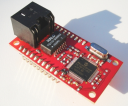Differences
This shows you the differences between two versions of the page.
| Both sides previous revision Previous revision Next revision | Previous revision | ||
|
en:netzer:networksettings [2012/08/10 11:46] svesch [Auto IP (from Version 1.4 pro)] Starting IP calculation added. |
en:netzer:networksettings [2014/02/09 14:32] (current) |
||
|---|---|---|---|
| Line 4: | Line 4: | ||
| Amendments will become effective only after restart, so that it is possible to correct incorrect entries. | Amendments will become effective only after restart, so that it is possible to correct incorrect entries. | ||
| + | |||
| + | <note important> | ||
| + | Some settings are available since Version 1.4 or 1.5. | ||
| + | You should consider updating to the latest Release. | ||
| + | </note> | ||
| {{networksettings.gif?nolink& |Settings on website}} | {{networksettings.gif?nolink& |Settings on website}} | ||
| + | |||
| Line 15: | Line 21: | ||
| - | ==== DHCP (from Version 1.4 pro) ==== | + | ==== DHCP ==== |
| In this mode, Netzer receives the IP address from a DHCP server. After restart, Netzer tries to contact the DHCP server via DHCP broadcast. If a DHCP server is available and prepared to provide an IP address, Netzer will receive its IP address in this way. | In this mode, Netzer receives the IP address from a DHCP server. After restart, Netzer tries to contact the DHCP server via DHCP broadcast. If a DHCP server is available and prepared to provide an IP address, Netzer will receive its IP address in this way. | ||
| Line 29: | Line 35: | ||
| - | ==== DHCP -> Manual IP (from Version 1.4 pro) ==== | + | ==== DHCP -> Manual IP ==== |
| Analog to mode [[networksettings#DHCP -> AutoIP (Default)|DHCP -> AutoIP]] Netzer tries to contact the DHCP server. Should the attempt fail, the IP data configured manually will be used (refer to mode [[networksettings#manual IP|manual IP]]). | Analog to mode [[networksettings#DHCP -> AutoIP (Default)|DHCP -> AutoIP]] Netzer tries to contact the DHCP server. Should the attempt fail, the IP data configured manually will be used (refer to mode [[networksettings#manual IP|manual IP]]). | ||
| - | ==== Auto IP (from Version 1.4 pro) ==== | + | ==== Auto IP ==== |
| In this mode, Netzer selects an IP address from AutoIP area 169.254.1.0 - 169.254.254.255 directly upon restart. The subnetwork mask is 255.255.0.0, a gateway address is not provided. Selection and provision of the AutoIP address is done following the [[wp>Zeroconf]] protocol. This guarantees tha the IP address is well-defined in the network. | In this mode, Netzer selects an IP address from AutoIP area 169.254.1.0 - 169.254.254.255 directly upon restart. The subnetwork mask is 255.255.0.0, a gateway address is not provided. Selection and provision of the AutoIP address is done following the [[wp>Zeroconf]] protocol. This guarantees tha the IP address is well-defined in the network. | ||
| - | The starting AutoIP is chosen in format 169.254.X.Y. X is the 5th number and Y the 6th number of the MAC address. If for example Netzer has the MAC address //00-04-a3-2c-3d-9f// than the IP address is 169.254.61.159. | + | The starting AutoIP is chosen in format 169.254.X.Y. X is the 5th number and Y the 6th number of the MAC address. If for example Netzer has the MAC address //00-04-a3-2c-3d-9f// than the IP address is //169.254.61.159//. |
| - | In AutoIP mode, the IP address has a minor role. Accordingly, the IP address actually used is not very easy to determine (exception: [[spislave|SPI Slave mode]]). Instead, other mechanisms are used to access devices in such a network, e.g. via the name of the device. | + | In AutoIP mode, the IP address has a minor role. Accordingly, the IP address actually used is not very easy to determine (exception: [[spislave|SPI Slave mode]]). Instead, other mechanisms are used to access devices in such a network, e.g. via the [[networksettings#Network name|name of the device]]. |
| Line 68: | Line 74: | ||
| - | ===== HTTP Port (from Version 1.4 pro) ===== | + | ===== HTTP Port ===== |
| If required (for Firewall reasons or for port forwarding) the port of the Netzer web interface can be changed. The port is published by the name service in the network, so that calls via Bonjour plug-ins are correctly switched to the appropriate port. If calling up the website via the IP address, the port is required to be coded into the URL. An example for port 8080: | If required (for Firewall reasons or for port forwarding) the port of the Netzer web interface can be changed. The port is published by the name service in the network, so that calls via Bonjour plug-ins are correctly switched to the appropriate port. If calling up the website via the IP address, the port is required to be coded into the URL. An example for port 8080: | ||



